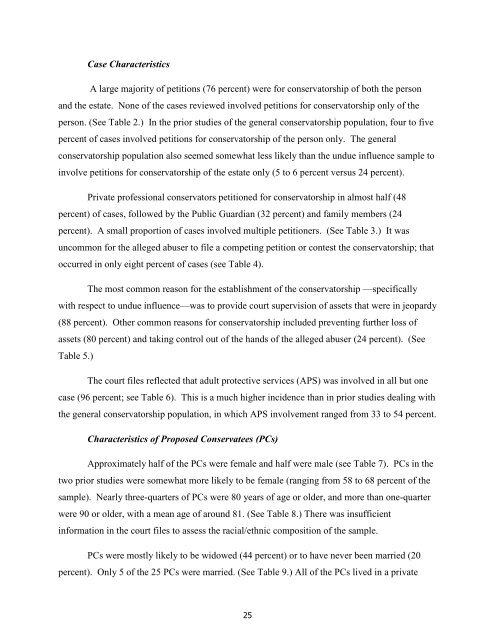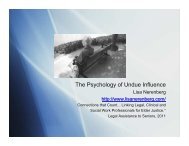Undue Influence: Definitions and Applications - California Courts ...
Undue Influence: Definitions and Applications - California Courts ...
Undue Influence: Definitions and Applications - California Courts ...
You also want an ePaper? Increase the reach of your titles
YUMPU automatically turns print PDFs into web optimized ePapers that Google loves.
Case Characteristics<br />
A large majority of petitions (76 percent) were for conservatorship of both the person<br />
<strong>and</strong> the estate. None of the cases reviewed involved petitions for conservatorship only of the<br />
person. (See Table 2.) In the prior studies of the general conservatorship population, four to five<br />
percent of cases involved petitions for conservatorship of the person only. The general<br />
conservatorship population also seemed somewhat less likely than the undue influence sample to<br />
involve petitions for conservatorship of the estate only (5 to 6 percent versus 24 percent).<br />
Private professional conservators petitioned for conservatorship in almost half (48<br />
percent) of cases, followed by the Public Guardian (32 percent) <strong>and</strong> family members (24<br />
percent). A small proportion of cases involved multiple petitioners. (See Table 3.) It was<br />
uncommon for the alleged abuser to file a competing petition or contest the conservatorship; that<br />
occurred in only eight percent of cases (see Table 4).<br />
The most common reason for the establishment of the conservatorship —specifically<br />
with respect to undue influence—was to provide court supervision of assets that were in jeopardy<br />
(88 percent). Other common reasons for conservatorship included preventing further loss of<br />
assets (80 percent) <strong>and</strong> taking control out of the h<strong>and</strong>s of the alleged abuser (24 percent). (See<br />
Table 5.)<br />
The court files reflected that adult protective services (APS) was involved in all but one<br />
case (96 percent; see Table 6). This is a much higher incidence than in prior studies dealing with<br />
the general conservatorship population, in which APS involvement ranged from 33 to 54 percent.<br />
Characteristics of Proposed Conservatees (PCs)<br />
Approximately half of the PCs were female <strong>and</strong> half were male (see Table 7). PCs in the<br />
two prior studies were somewhat more likely to be female (ranging from 58 to 68 percent of the<br />
sample). Nearly three-quarters of PCs were 80 years of age or older, <strong>and</strong> more than one-quarter<br />
were 90 or older, with a mean age of around 81. (See Table 8.) There was insufficient<br />
information in the court files to assess the racial/ethnic composition of the sample.<br />
PCs were mostly likely to be widowed (44 percent) or to have never been married (20<br />
percent). Only 5 of the 25 PCs were married. (See Table 9.) All of the PCs lived in a private<br />
25




